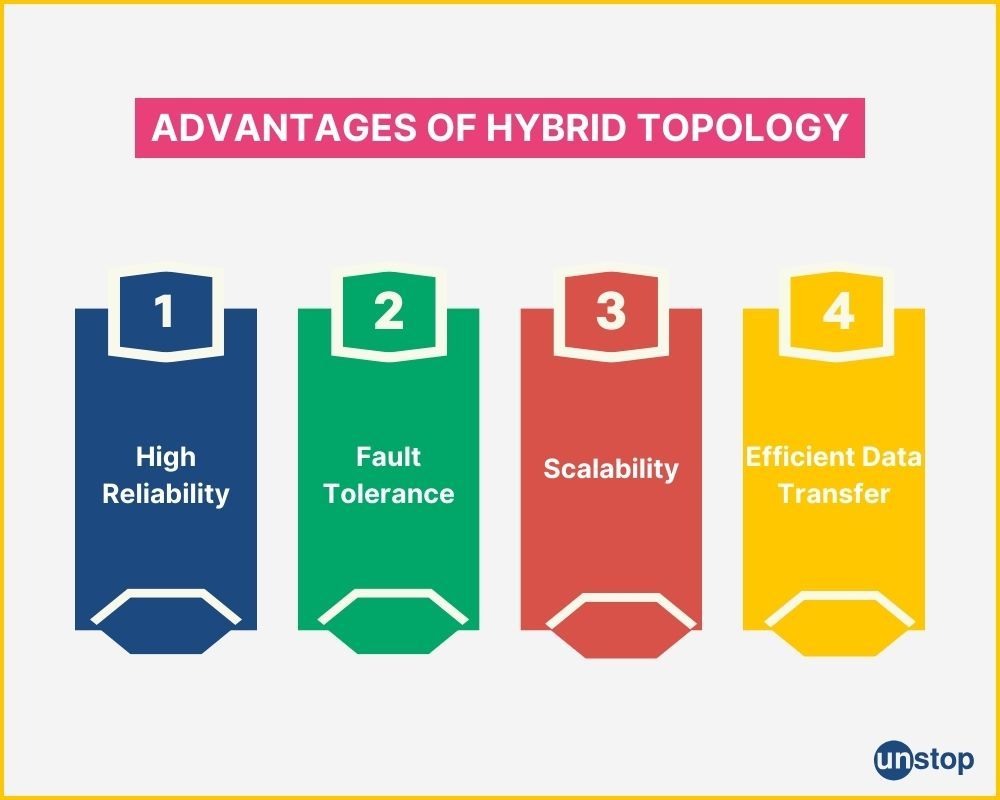- Basic Characteristics Of Hybrid Topology
- Defining Features Of Hybrid Topology
- Types Of Hybrid Topology
- Examples Of Hybrid Topology
- Advantages Of Hybrid Topology
- Disadvantages Of Hybrid Topology
- Applications Of Hybrid Topology
- Star-Ring & Star-Bus Hybrid Topologies
- Frequently Asked Questions
Hybrid Topology In Computer Network Explained In Detail (+Images)

Hybrid topology combines two or more different topologies when building a computer network. For example, one may combine the star and ring structures to create a strong network that efficiently moves data between connected nodes while ensuring redundancy for smooth operations.
Hybrid topology is highly beneficial and commonly utilized across various industries because of its adaptability and practicality in today's technology-driven world.
Basic Characteristics Of Hybrid Topology
Let us study some of the basic characteristics of hybrid topology:
Flexibility & Scalability
Hybrid topology combines different network structures, offering flexibility and scalability. For instance, a hybrid network may integrate the star and mesh topologies. This blend allows for diverse configurations to suit varying needs.
A hybrid topology's scalability is advantageous as it can adapt to changing requirements without overhauling the entire network. Adding new devices or expanding current ones doesn't disrupt existing connections, ensuring smooth operations.
Efficient Data Transmission
In a hybrid topology, data transmission efficiency is enhanced by leveraging the strengths of multiple topologies.
For example, combining bus and ring topologies can improve data transfer speeds while maintaining reliability through redundant paths.
Defining Features Of Hybrid Topology
Let us study in detail the key features of hybrid topology:
Utilizes Different Types
A hybrid topology is created by combining multiple network topologies, enabling organizations to utilize the advantages of each type.
- For instance, a hybrid network might incorporate both star and mesh topologies to optimize performance and reliability.
- This blending of network connections enhances redundancy and fault tolerance.
- With multiple types of connections in place, data can still flow through alternative paths without disrupting the entire network if one segment fails.
- This redundancy is crucial for ensuring continuous operations in case of failures.
Customization Based on Needs
One significant advantage of a hybrid topology is its ability to be tailored based on specific requirements.
- Organizations can customize their networks by selecting the most suitable topologies that align with their operational needs.
- For example, a company needing high-speed connections between critical devices may opt for bus and ring topologies within their hybrid setup.
Types Of Hybrid Topology
Let us study the types of hybrid topology:
Star-Ring Hybrid Topology
A star-ring hybrid topology combines the characteristics of both star and ring topologies. In this setup, devices are connected in a star formation at first and then linked in a circular manner like a ring. This combination offers redundancy as data can flow through multiple paths, enhancing network reliability.
This type is beneficial for organizations requiring fault tolerance and high availability. However, it may be complex to design and maintain due to its dual nature.
Star-Bus Hybrid Topology
In a star-bus hybrid topology, star and bus configuration elements are integrated. Devices connect in a central hub like a star while sharing communication lines like a bus structure.
This architecture simplifies troubleshooting by segmenting network sections.
Tree Hybrid Topology
Tree Hybrid Topology blends features of various types, such as hierarchical networks, with others, like mesh or backbone arrangements, to create intricate structures that suit specific organizational needs.
Examples Of Hybrid Topology
Let us study some examples of hybrid topology:
Internet Service Providers
Internet Service Providers (ISPs) often implement hybrid topologies to enhance network reliability and performance. By combining different network topologies, ISPs can ensure a more robust and efficient user connection.
For instance, an ISP may combine star and mesh topologies to create a hybrid network offering centralized control and decentralized redundancy.
Hybrid Topology In Large Organizations
Large organizations with multiple branches frequently rely on hybrid networks to streamline communication and data sharing across various locations. These networks blend the advantages of different topologies, such as bus, ring, or tree structures.
Data Centers
Hybrid topologies are frequently used in data centers to manage data effectively. Companies can enhance data storage, processing speed, and fault tolerance by combining network layouts like star, mesh, or ring within the data center structure.
Advantages Of Hybrid Topology
Let us study the advantages of hybrid topology:

High Reliability
Hybrid topology offers high reliability by combining different network architectures, such as star and ring topologies. This configuration ensures that if one section fails, other parts remain operational.
For example, in a hybrid network consisting of wired and wireless connections, data can still flow through the wireless segment if the wired connection encounters an issue.
Fault Tolerance
Hybrid topology provides fault tolerance, which can withstand failures without compromising the entire network's functionality. By having multiple interconnected components within the system, any disruptions are contained to specific sections rather than affecting the whole network.
Scalability
One significant advantage of hybrid topology is its scalability. As businesses expand or require more network devices, hybrid configurations can easily accommodate this growth by adding new components or adjusting existing ones to meet increased demand.
This flexibility makes it a preferred option for organizations with dynamic networking needs.
Efficient Data Transfer
In a hybrid topology, data can be transferred through multiple paths, reducing the risk of network congestion and increasing overall reliability.
For example, if one path becomes congested or fails, data can be rerouted through an alternate path, ensuring continuous data transfer.
Disadvantages Of Hybrid Topology
Let us also study some of the disadvantages of hybrid topology:
Additional Resources
Implementing a hybrid topology demands extra resources for both setup and maintenance. This can strain the budget since it requires investing in different types of equipment to support the diverse network structure.
For instance, if a company transitions from a traditional network to a hybrid one, it may need additional routers and switches.
Higher Costs Of Equipment & Configuration
Maintaining an entire network with multiple connection points increases complexity, potentially leading to higher costs associated with equipment and configuration.
Managing these varied components can be challenging when integrating different types of networks like bus and star topologies within a hybrid framework. The need for specialized knowledge or hiring experts might arise due to this intricate setup.
Security Vulnerabilities
One significant concern linked with hybrid topologies is the heightened risk of security breaches. With multiple connection points across various networking technologies, the chances of failure or unauthorized access increase significantly.
Unethical elements may exploit vulnerabilities at any point where different networks intersect, jeopardizing data integrity and confidentiality.
Applications Of Hybrid Topology
Let us study some of the applications of hybrid topology:
Ideal for Organizations
Hybrid topology works well for companies that require both local area networks (LANs) and wide area networks (WANs). It is also suitable for businesses with geographically dispersed locations, allowing seamless data flow between branches.
This layout is commonly used in telecommunications, banking, and healthcare industries.
Common Industries Using Hybrid Topology
Industries such as telecommunications, banking, and healthcare benefit greatly from hybrid topology. Telecommunications companies often have a mix of wired and wireless connections within their network layout.

Banks with multiple branches need secure connections between offices, making hybrid topology ideal for such setups. Hospitals may require a mix of wired connections for administrative tasks in the healthcare sector while using wireless links in patient care areas.
Star-Ring & Star-Bus Hybrid Topologies
Let us explore the star-ring and star-bus hybrid topologies:
Star-Ring Hybrid Topology
A hybrid topology merges the star and ring structures, combining the star's central hub with the ring's circular arrangement. This integration allows for redundancy by offering multiple pathways for data transmission.
In this setup, each device connects to a central hub like in a star network but also forms a closed loop, as in a ring network.
The star-ring hybrid topology benefits organizations requiring centralized control from the hub and resilience from redundant paths.
For instance, research organizations can utilize this configuration to ensure seamless communication between departments while maintaining data integrity through backup routes.
Star-Bus Hybrid Topology
A Star-bus hybrid topology combines elements of both star and bus network topologies. This setup connects multiple star topologies using a central bus backbone.
- Each star network operates independently, with its main hub connecting individual devices, while the bus backbone facilitates communication between different star networks.
- This hybrid approach offers the benefits of scalability and fault tolerance from the star topology, along with the efficiency and simplicity of the bus topology.
- It provides a flexible and robust network architecture suitable for medium to large-scale environments where a combination of centralized and decentralized communication is required.
Conclusion
In conclusion, understanding hybrid topology is crucial for optimizing network efficiency. The defined features, types, advantages, and disadvantages all significantly shape network structures.
Embracing the flexibility and reliability of hybrid topologies can lead to optimized performance and streamlined operations in diverse networking environments.
Frequently Asked Questions
1. What is a Hybrid Topology?
A hybrid topology combines two or more network topologies, such as star, ring, bus, or mesh. Organizations can combine different network structures to build a strong and adaptable network environment.
2. What are the advantages of using a Hybrid Topology?
Hybrid topologies offer enhanced scalability, fault tolerance, and flexibility by combining the benefits of different network architectures. They can optimize performance based on specific needs and ensure reliable connectivity in complex environments.
3. Can you provide examples of Hybrid Topologies?
Examples include combining star and ring (star-ring), star and bus (star-bus), or tree with other topologies. Each combination serves unique purposes like balancing traffic flow efficiently or improving fault tolerance in critical network segments.
4. How are Tree and Hybrid Topologies compared in networking?
Tree topology resembles hierarchical structures used for data distribution, while hybrid topology integrates diverse layouts for improved functionality. Tree networks have centralized control with branching subnets; hybrids combine various designs to enhance overall system performance dynamically.
5. In what applications are Hybrid Topologies commonly used?
Hybrid topologies find applications in large enterprises where varied requirements demand adaptable networks. They are suitable for complex setups requiring high reliability through redundancy and efficient data transfer mechanisms across different departments or locations.
Suggested reads:
- Future Of Job Report 2023: AI & Machine Learning Trends For The Next 5 Years
- Learn How ChatGPT For Machine Learning Works: A Beginner's Guide
- Understanding Cloud Computing Architecture
- What Is Cache Memory In Computer? Understand the Basics
- What is Flow Control in Computer Networks? Understand In Detail
Instinctively, I fall for nature, music, humor, reading, writing, listening, traveling, observing, learning, unlearning, friendship, exercise, etc., all these from the cradle to the grave- that's ME! It's my irrefutable belief in the uniqueness of all. I'll vehemently defend your right to be your best while I expect the same from you!
Login to continue reading
And access exclusive content, personalized recommendations, and career-boosting opportunities.
Subscribe
to our newsletter
















Comments
Add comment